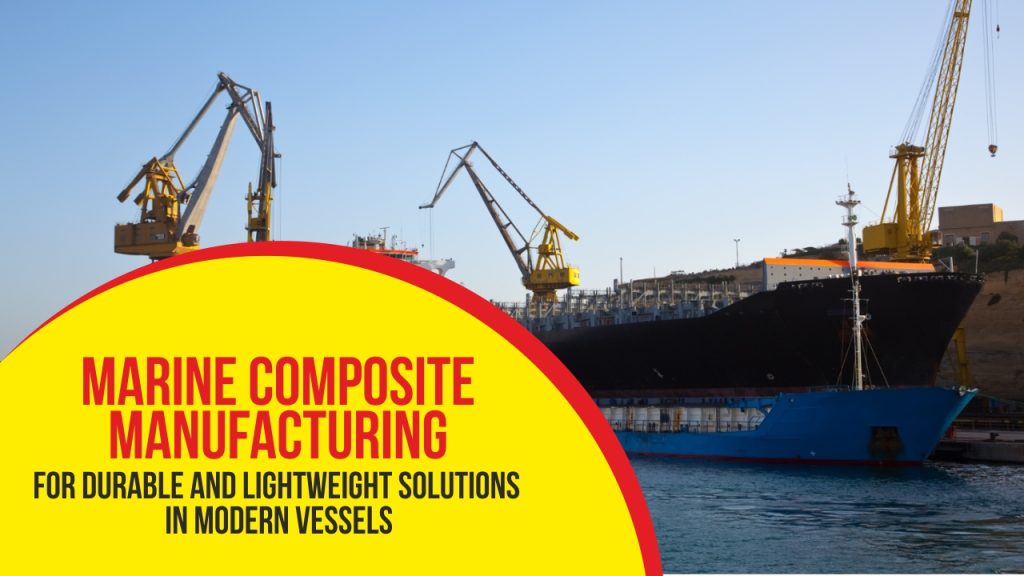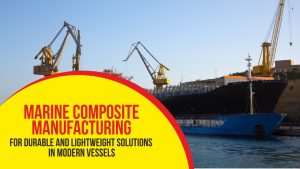Marine engineering has always demanded materials that balance strength, durability, and weight efficiency. Marine composite manufacturing has emerged as a critical solution, reshaping how vessels are designed and built for both commercial and recreational use. By combining high-performance fibers with advanced resin systems, manufacturers are creating structures that withstand harsh marine environments while ensuring efficiency and long service life.
Why Marine Composites are Transforming Vessel Design
Traditional materials like steel and aluminium, while strong, come with limitations such as higher weight, corrosion, and higher maintenance costs. Marine composites overcome these challenges through unique advantages:
- Lightweight construction– Reduces fuel consumption and enhances vessel speed.
- Corrosion resistance– Essential for prolonged exposure to seawater.
- High strength-to-weight ratio– Offers superior structural integrity without unnecessary bulk.
- Design flexibility– Allows manufacturers to create complex geometries and streamlined vessel shapes.
These properties have made composites a preferred choice for naval vessels, luxury yachts, ferries, and even advanced submarines.
Key Materials Used in Marine Composite Manufacturing
The selection of fibers and resins determines the performance of the final structure. Some of the most widely used materials include:
- Glass Fiber Reinforced Plastic (GFRP): Cost-effective, durable, and widely used for hulls and decks.
- Carbon Fiber Reinforced Plastic (CFRP): Lightweight with exceptional stiffness, ideal for performance vessels.
- Aramid Fibers (Kevlar): Known for impact resistance, often used in high-speed crafts and military applications.
- Epoxy Resins: Provide excellent bonding, chemical resistance, and mechanical properties.
- Vinyl Ester Resins: Offer superior corrosion resistance, commonly used in aggressive saltwater environments.
Combining these materials enables manufacturers to tailor composites for specific vessel types, balancing performance and cost efficiency.
Manufacturing Techniques in Marine Composites
Marine composite manufacturing is not a one-size-fits-all process. Depending on vessel size, performance requirements, and cost considerations, different techniques are used:
- Hand Lay-Up Process
One of the earliest and most common methods, where fiber mats are manually placed and saturated with resin. Ideal for smaller vessels and simpler designs. - Vacuum Infusion
A process where resin is drawn into dry fibers under vacuum pressure, ensuring uniform distribution and reduced voids. It delivers higher-quality laminates with better strength and lighter weight. - Resin Transfer Molding (RTM)
A closed-mold process that produces consistent parts with smooth finishes. It is efficient for large-scale production of composite components. - Prepreg Lay-Up with Autoclave Curing
Used for high-performance marine applications, especially with carbon fiber. Pre-impregnated fabrics are laid in molds and cured under high pressure and temperature, resulting in premium-quality structures. - Pultrusion and Filament Winding
Suitable for manufacturing masts, spars, and cylindrical structures, ensuring uniformity and high mechanical strength.
Each of these processes offers unique benefits, and the choice depends on project requirements, production scale, and desired performance outcomes.
Advantages of Marine Composites in Vessel Performance
The benefits extend beyond just weight reduction and durability. Vessel builders and operators gain multiple performance and operational advantages, such as:
- Fuel efficiency: Lightweight composites reduce drag, enhancing energy efficiency and lowering operating costs.
- Speed and maneuverability: High strength-to-weight ratios improve acceleration and responsiveness.
- Longer lifecycle: Reduced corrosion and fatigue issues translate into fewer repairs and replacements.
- Passenger comfort: Vibration and noise reduction in composite vessels improve onboard experience.
- Sustainability: Reduced fuel usage and extended service life contribute to environmentally responsible operations.
Applications Across the Marine Industry
The versatility of composites allows their use across diverse marine sectors:
- Commercial Shipping:Hulls, superstructures, and decking materials that enhance durability in cargo and passenger ships.
- Defense and Naval Vessels:Lightweight, high-strength materials improve stealth, speed, and maneuverability.
- Recreational Yachts and Boats:Sleek designs with luxury finishes that combine performance with aesthetics.
- Offshore Structures:Platforms, buoys, and underwater equipment that demand corrosion resistance and durability.
- High-Speed Ferries:Composite construction reduces energy demands while meeting stringent safety standards.
Innovation Driving the Future of Marine Composite Manufacturing
Advancements in digital design, automation, and materials science are pushing boundaries in marine construction. Some innovations shaping the future include:
- Nano-enhanced composites for improved mechanical strength and resistance.
- Recyclable thermoplastic composites that support sustainability goals.
- 3D printing in composites for rapid prototyping and complex geometries.
- Hybrid material systems combining carbon, glass, and aramid fibers for optimized performance.
These innovations are enabling manufacturers to deliver vessels that are not only lighter and stronger but also more environmentally friendly and cost-effective.
Rockman Advanced Composites – Pioneering Excellence in Marine Composites
At Rockman Advanced Composites, we specialize in advanced composite solutions tailored for the marine industry. Our expertise spans material selection, process optimization, and precision engineering to deliver high-performance components for a wide range of vessels. By leveraging cutting-edge technologies and world-class facilities, we ensure our solutions meet the highest standards of durability, safety, and efficiency.
Our commitment lies in helping shipbuilders and marine operators achieve long-lasting performance advantages through innovative composite applications. From high-speed crafts to offshore platforms, we provide customized solutions that combine engineering excellence with material innovation.
Conclusion
Marine composite manufacturing has redefined vessel construction by offering lightweight, durable, and versatile alternatives to traditional materials. As the marine industry continues to evolve, the demand for advanced composites will only grow stronger. Companies that embrace these materials and processes gain significant advantages in performance, efficiency, and sustainability.
Rockman Advanced Composites remains at the forefront of this transformation, delivering tailored composite solutions that meet the rigorous demands of modern vessels. By focusing on innovation, quality, and customer needs, we continue to contribute to a future where marine transportation is safer, faster, and more sustainable.








